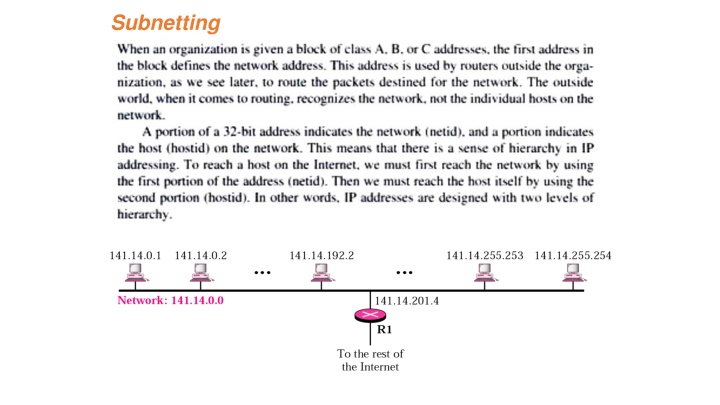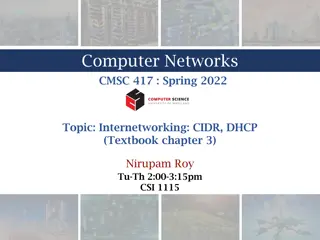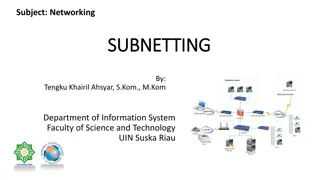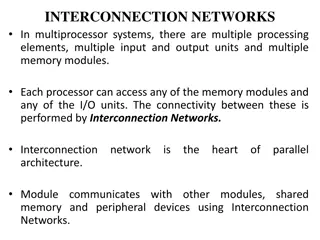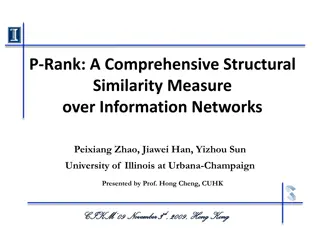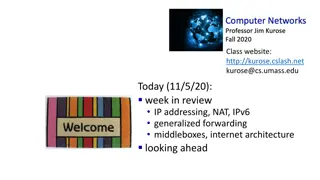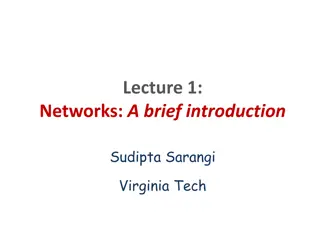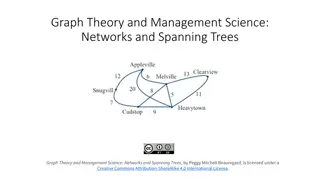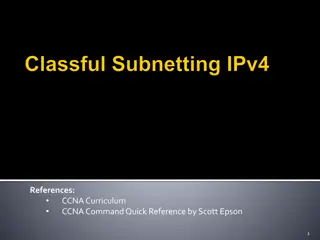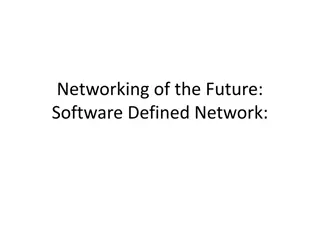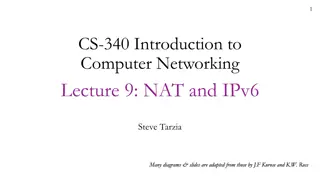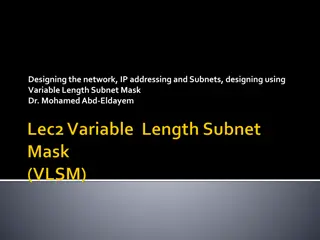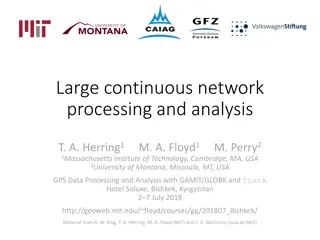Introduction to Subnetting: Managing Networks Efficiently
Subnetting is a key networking concept that involves dividing a large network into smaller segments for better management, reduced broadcast traffic, and efficient troubleshooting. By segmenting networks, different departments can have their own bandwidth, minimizing data collisions and delays in data access times. Subnet masks play a crucial role in assigning subnet numbers to nodes within a network. Learn how subnetting enhances network performance and simplifies network administration.
Download Presentation

Please find below an Image/Link to download the presentation.
The content on the website is provided AS IS for your information and personal use only. It may not be sold, licensed, or shared on other websites without obtaining consent from the author.If you encounter any issues during the download, it is possible that the publisher has removed the file from their server.
You are allowed to download the files provided on this website for personal or commercial use, subject to the condition that they are used lawfully. All files are the property of their respective owners.
The content on the website is provided AS IS for your information and personal use only. It may not be sold, licensed, or shared on other websites without obtaining consent from the author.
E N D
Presentation Transcript
Purpose of subnetting One of the main reasons for subnetting is to split one large network into smaller, logical chunks of space. This makes things easier to manage and also keeps problems restricted to their own subnets. Broadcast traffic is minimized throughout the network and is contained in each group s network structure. This helps significantly with troubleshooting issues and isolating problems on the network. Another good reason for subnetting is having two portions of the network that are geographically separated from one another. Each remote site connects using a router s WAN link and uses separate network IDs in the IP address to split them logically. They still belong to the same overall corporate network but are divided into subnets for management and location-related reasons.The outside world still sees the network as one complete network.
Individual departments may have very different volumes of network traffic. One department may have a high volume of daily network traffic and another department, a significantly lower amount. If these departments coexist on the same logical network, they will be competing for network bandwidth and can cause major delays in data access times. By separating or segmenting these departments, each department is allocated its own bandwidth, and data collisions are minimized. Data traffic from one subnet will not interfere with the other subnet. This separation of subnetworks is also beneficial for subnets using different LAN protocols on the same network.
subnet mask The mechanism by which a single network number can be shared among multiple networks involves configuring all the nodes on each subnet with a subnet mask. With simple IP addresses, all hosts on the same network must have the same network number. The subnet mask enables us to introduce a subnet number; all hosts on the same physical network will have the same subnet number. What the subnet mask effectively does is introduce another level of hierarchy into the IP address.
Example : A router inside the organization receives the same packet with destination address 190.240.33.91. Show how it finds the subnetwork address to route the packet. The router follows three steps: 1. The router must know the mask. We assume it is /19. 2. The router applies the mask to the address, 190.240.33.91. The subnet address is 190.240.32.0. 3. The router looks in its routing table to find how to route the packet to this destination. Later, we will see what happens if this destination does not exist.
Routing We have three functions related to routing issue : the delivery, forwarding, and routing of IP packets to their final destinations. -Delivery refers to the way a packet is handled by the underlying networks under the control of the network layer. -Forwarding refers to the way a packet is delivered to the next station. -Routing refers to the way routing tables are created to help in forwarding. Routing protocols are used to continuously update the routing tables that are consulted for forwarding and routing. DELIVERY The network layer supervises the handling of the packets by the underlying physical networks. We define this handling as the delivery of a packet. The delivery of a packet to its final destination is accomplished by using two different methods of delivery, direct and indirect
Direct Delivery In a direct delivery, the final destination of the packet is a host connected to the same physical network as the deliverer. Direct delivery occurs when the source and destination of the packet are located on the same physical network or when the delivery is between the last router and the destination host. The sender can easily determine if the delivery is direct. It can extract the network address of the destination (using the mask) and compare this address with the addresses of the networks to which it is connected. If a match is found, the delivery is direct.
Indirect Delivery If the destination host is not on the same network as the deliverer, the packet is delivered indirectly. In an indirect delivery, the packet goes from router to router until it reaches the one connected to the same physical network as its final destination. A delivery always involves one direct delivery but zero or more indirect deliveries. Also the last delivery is always a direct delivery.
FORWARDING Forwarding means to place the packet in its route to its destination. Forwarding requires a host or a router to have a routing table. When a host has a packet to send or when a router has received a packet to be forwarded, it looks at this table to find the route to the final destination. However, this simple solution is impossible today in an internetwork such as the Internet because the number of entries needed in the routing table would make table lookups inefficient. Forwarding Techniques : Several techniques can make the size of the routing table manageable and also handle issues such as security. 1) Next-Hop Method A technique to reduce the contents of a routing table. In this technique, the routing table holds only the address of the next hop instead of information about the complete route (route method).
2) Network-Specific Method A second technique to reduce the routing table and simplify the searching process. Instead of having an entry for every destination host connected to the same physical network (host-specific method), we have only one entry that defines the address of the destination network itself.
3) Default Method Another technique to simplify routing is called the default method. In the following figure, host A is connected to a network with two routers. Router Rl routes the packets to hosts connected to network N2. However, for the rest of the Internet, router R2 is used. So instead of listing all networks in the entire Internet, host A can just have one entry called the default (normally defined as network address 0.0.0.0).
